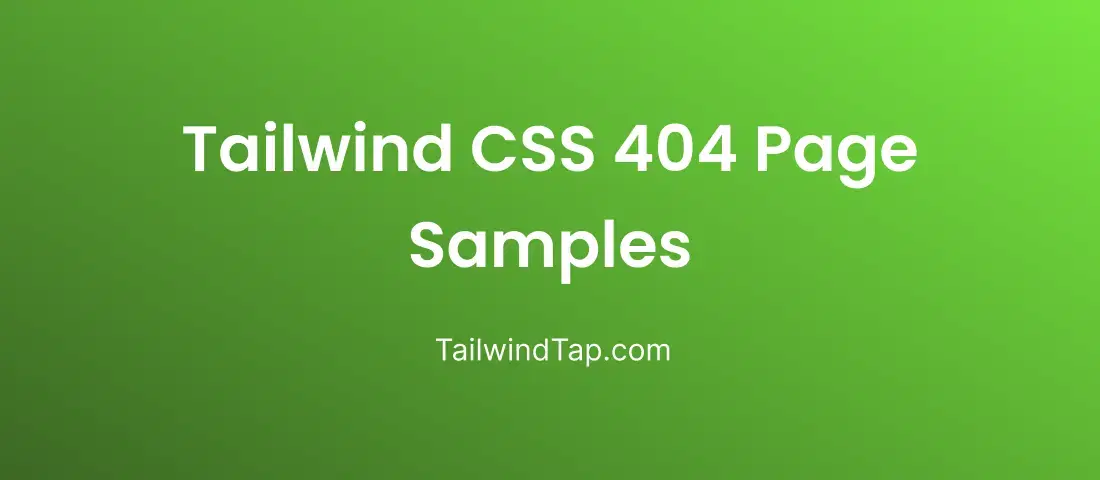A well-designed 404 error page offers an opportunity to engage users and keep them exploring your website in addition to being a polite gesture. You can design beautiful and useful 404 pages that improve user experience and showcase your brand's style by dynamically combining Tailwind CSS with Next.js. With the use of real-world examples and detailed instructions, we'll explore the craft of creating appealing 404 pages in a Next.js application in this blog post.
Why Your 404 Page Matters:
When users encounter a 404 error page, it's a moment of confusion and disappointment. However, your response can turn this negative experience into a positive one. An intelligently designed 404 page can redirect users to relevant content, reassure them that the error isn't their fault, and even inject a bit of humor to lighten the mood. By making your 404 page more than just a dead end, you show users that you value their time and effort.
Why Tailwind CSS:
Tailwind CSS is a utility-first CSS framework that allows developers to rapidly build user interfaces without writing custom CSS. Its pre-designed classes enable quick styling and responsive design. Combining Tailwind CSS with Next.js and React provides a seamless way to create dynamic and visually appealing 404 pages.
Example 1: The Minimalist Approach
In this example, we'll create a clean and simple 404 page using Tailwind CSS. The focus here is on delivering a clear message and guiding users back to familiar territory.
<div class="min-h-screen flex flex-grow items-center justify-center bg-gray-50">
<div class="rounded-lg bg-white p-8 text-center shadow-xl">
<h1 class="mb-4 text-4xl font-bold">404</h1>
<p class="text-gray-600">Oops! The page you are looking for could not be found.</p>
<a href="/" class="mt-4 inline-block rounded bg-blue-500 px-4 py-2 font-semibold text-white hover:bg-blue-600"> Go back to Home </a>
</div>
</div>

Example 2: Search and Navigate
Transform your 404 error page into a helpful hub by incorporating a search bar and navigation links.
<div class="flex flex-col bg-gray-50 items-center justify-center h-screen">
<h1 class="text-4xl font-bold mb-4">404 - Not Found</h1>
<p class="text-gray-600">Sorry, the page you're looking for doesn't exist.</p>
<div class="mt-6">
<input
type="text"
placeholder="Search for content..."
class="px-4 py-2 border rounded-lg focus:outline-none focus:border-blue-500"
/>
</div>
<div class="mt-4 text-center">
<p class="text-gray-600 mb-3">Or, you might want to explore:</p>
<a href="/" class="text-blue-500 hover:underline">Home</a>
<a href="/blog" class="text-blue-500 hover:underline ml-2">Blog</a>
<a href="/contact" class="text-blue-500 hover:underline ml-2">Contact</a>
</div>
</div>

Example 3: Playful Animations
<div class="text-center">
<h1 class="mb-4 text-6xl font-semibold text-red-500">404</h1>
<p class="mb-4 text-lg text-gray-600">Oops! Looks like you're lost.</p>
<div class="animate-bounce">
<svg class="mx-auto h-16 w-16 text-red-500" fill="none" viewBox="0 0 24 24" stroke="currentColor">
<path stroke-linecap="round" stroke-linejoin="round" stroke-width="2" d="M12 19l9 2-9-18-9 18 9-2zm0 0v-8"></path>
</svg>
</div>
<p class="mt-4 text-gray-600">Let's get you back <a href="/" class="text-blue-500">home</a>.</p>
</div>
</div>

Read More :
- Exploring Tailwind CSS Border Width: Tips and Examples
- Mastering Border Radius in Tailwind CSS: A Comprehensive Guide
- Mastering Border-x and Border-y in Tailwind CSS: A Comprehensive Guide
💡 FAQs About Tailwind CSS 404 Page Samples
Q1. How can I integrate custom images or illustrations into my 404 error pages using Tailwind CSS?
The article demonstrates various designs but does not cover how to incorporate custom visuals, which can enhance the branding and visual appeal of error pages.
Q2. What are some best practices for ensuring that the 404 page design is responsive across different devices and screen sizes?
While the post provides example designs, here all the examples are totally responsive and mobile-compatible.
Q3. How do I handle logging and tracking 404 errors to better understand and address the causes of these errors?
The article focuses on the design aspect of 404 pages but does not discuss how to implement logging and analytics to monitor the occurrence of 404 errors and gather data for improving the website.
